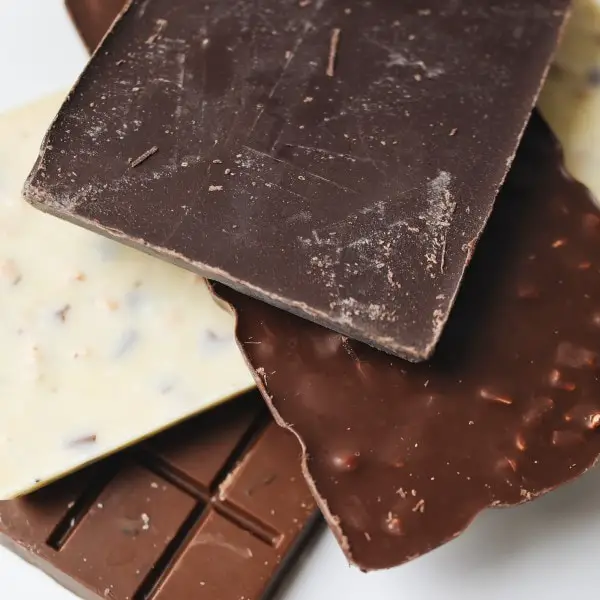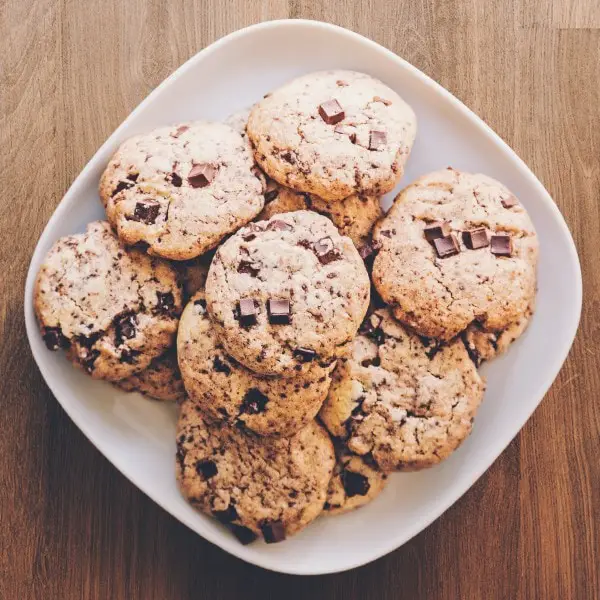Chewy yet crispy, crunchy yet soft, sweet yet bitter, the ultimate chocolate chip cookie is impossible to fully describe. A delicate balance between the senses, combining a hint of saltiness and an underlying remnant of vanilla, a great chocolate chip cookie will leave you begging for more.
What make a great chocolate chip cookie?
A great chocolate chip cookie needs to hit 2 spots:
- It needs to deliver at least 1 hit of chocolate per bite. But not just any chocolate! As the cookie dough is already sweet, the chocolate has to present enough contrast to the cookie to be noticed, but not so much that it throws you off.
- Pure milk chocolate is too sweet, with not enough cocoa to make it stand out.
- Pure dark chocolate is too bitter and while some may love this, for most, it will be an unwelcome distraction.
- It needs to deliver a chewy mouthful that is neither too soft nor too crunchy. This is hard to achieve as the dough keeps cooking once out of the oven, so the timing must be just right. The edges must be firm so you can feel the cookie but the center must give and melt in the mouth.
How to get a perfect blend of chocolate?

- Avoid cooking chocolate or those “oh so convenient” chocolate drops that so many cooks love. While these are the right size to melt just a little but not disappear during the baking, they do nothing for the taste.
- Chop your own chocolate into medium chunk, about as big as one-to-two corn/maize kernels. This should be large enough that it does not melt too much in the oven. Smaller or larger bits will be fine and add texture.
- If you can find the right semi-dark chocolate, buy that, it will be easier. But often high quality dark chocolate slabs are too thin. They also tend not to have enough fat in them to blend in with the cookie, giving a watery taste.
- I prefer to use a mix of good milk and dark chocolate chopped and mixed together. This gives the fattiness of the milk chocolate which tends to melt more and the surprise bite of bitter dark chocolate as a flavour enhancer. Using 2 types of chocolate also allows you to tweak the recipe to your own personal preference by playing with the ratio of the dark to milk chocolate.
Can I Use the Same Recipe to Make Chocolate Chip Cookies and Homemade Biscuits?
Yes, you can use the same foolproof homemade biscuits recipe to make chocolate chip cookies. Simply add chocolate chips to the biscuit dough and adjust the baking time for a delicious twist on classic cookies. The versatile recipe allows for endless variations to satisfy everyone’s sweet tooth.
How to make more chewy cookies?
A chewy cookie simply has a higher moisture level. This is why so many cookies are soft when freshly baked and rock-hard when cooled. There are 8 easy ways to make your cookies more chewy. I list them in my personal order of preference:
- Replace some of the white sugar with brown sugar. Brown sugar is more moist than white sugar. There is a range from light brown sugar to demerara to treacle sugar. I tend to use treacle sugar as I can see the moisture and it tends to give me a deeper, much more caramelized flavour. Replace the white sugar on a 1-1 ratio.
- Add some molasses. Molasses are simply leftovers from the sugar refining process and have the added advantage of being packed with vitamins and minerals such as iron, calcium, magnesium and selenium1. As you are after the flavour and moisture, do not add more than 1 tablespoon. Remove 1 tablespoon of sugar.
- Add some honey. If molasses is not an option, use honey instead. This is a natural ingredient and is also high in moisture. Honey can also beneficial, when used carefully and has a much more subdued flavour profile2.
- Replace the butter with shortening, which is 100% pure fat. Butter is an emulsion of fat, milk solids and water3 and therefore releases steam during the cooking process, which dries the cookies. Shortening can be any oil or fat, but the best is to use hydrogenated vegetable oil shortening, which remains semi-solid at room temperature. While two are different, they can be used interchangeably on a 1 to 1 ratio.
- Lower your oven temperature. Most recipes bake the cookies around 350F or 175C. This is quite high and drives out most of the moisture, making thee cooking to get crispier. Lowering the baking temperature to 325F or 160C will keep the cookies moist.
- The alternative is to adjust the baking time. The longer you bake your cookies, the more moisture is driven off. Carefully shaving off 2-3 minutes by monitoring the edges of the cookies and removing them when the edges just turn golden brown and the center looks set but not brown. Remember, the cookies will keep losing moisture as they cool down.
- A similar approach is to cool the dough, or rest it, in the fridge for an hour to three days. Sugar absorbs moisture relatively slowly, thus the longer the dough is in the fridge, the more moisture is trapped by the sugar. In addition, chilling the dough allows the fat to solidify, which means that it will take longer to melt in an oven and the cookies will spread less. A thicker cookie will retain moisture better and remain chewier than a thin-flat cookie. A chilled dough also has the same effect as baking for less long as more time is required to bring the center of the cookie to the baking temperature.
- Melt your butter and replace half the eggs with egg yolks and 2 tablespoons of milk per egg yolk. Melted butter cannot be creamed, which reduces the amount of air in the cookie, making it denser and chewier while eggs whites trap moisture themselves but release it very quickly.
How to ensure that cookies stay chewy?
Cookies stay chewy by not losing moisture… simple as that. Thus the trick is to ensure that the cookies, if not eaten the same hour, are stored in a way to preserve moisture. The following 5 methods of storing cookies should extend the life of the perfectly chewy cookie by a week.
- Do not overcook the cookies. They should still look underdone in the middle. While they cool, the center will harden a bit and the cookie will be perfect. Overcooked cookies will dry up as soon as they cool.
- Store the cookies as soon as they are cooled. The longer they stay out in the open, the more moisture gets driven off and the crispier they will get. Unfortunately, this is a one-way process and cannot be reversed.
- Store the cookies in and air-tight container. Ziplock bags, Tupperware or a simple jar with a lid will prevent excessive moisture loss. However, do not rush this process as storing hot cookies in an airtight container can cause condensation and make the cookies crumbly.
- Add a slice of fresh sandwich bread to your cookies. As odd as it sounds, this technique works as sandwich bread contains a lot of moisture that will increase the moisture level in the container, which slows down the moisture loss from the cookies, leaving the bread a dry husk, at which point, replace the bread.
- Use a flour tortilla or even a low-carb tortilla. These contain more moisture and are flatter than bread, making them ideal for smaller containers.
How to freeze the chocolate chip cookie dough?
- Roll the dough into balls and freeze on the tray.
- Once they are frozen, transfer to a Tupperware or a Ziplock bag. They can be packed tightly.
- Place them back on a parchment paper covered tray to thaw, leaving plenty of room (3 inches or 8 cm between each ball). Leave to defrost for 1-2 hours before baking.
- To cook from frozen, place the tray with the dough in the oven as you preheat the oven and bake for 15 minutes. The cookies may look darker than usual but will still taste amazing.
Simply the best Chocolate Chip Cookies
Course: Teatime, Snacks, PartyCuisine: English, AmericanDifficulty: Easy12
servings30
minutes12
minutes488
kcal42
minutesA good chocolate chip cookie should be soft, chewy, chocolaty, sweet. White sugar provides crunch while brown sugar makes the cookie chewy. Dark chocolate is used to provide a bitter undertone that makes the milk chocolate more powerful..
Ingredients
3 1/4 cup (420g) flour.
1 cup (225g) butter, chopped into cubes.
1 1/4 teaspoon baking powder.
1 teaspoon baking soda.
1 1/4 cup (320g) light brown sugar (demerara or treacle will also work).
1/2 cup (100g) sugar.
2 eggs.
Directions
- In a medium saucepan, melt the butter over very low heat.
- Whisk the flour, baking powder, baking soda and salt in a large bowl.
- Pour the melted butter in a large bowl and add in the two sugars and whisk until evenly distributed.
- Add the first egg and whisk until incorporated. Add the 2nd egg and whisk again.
- Add in the vanilla and whisk again.
- With a wooden or silicone spatula, carefully add in the flour mix and fold until mostly combined.
- Chop the chocolates into small bits, but not too small as they need to melt just a little into the cookie.
- Add the chocolates to the dough and fold in gently.
- Refrigerate the dough for 5 minutes.
- Line 2 baking sheets with parchment paper.
- Preheat the oven to 180C.
- Take 3 tablespoons of dough and roll into a ball, place onto the tray, leaving about 8 cm between each ball.
- Bake in the oven for 8 minutes, then turn the trays around and bake for a further 4-6 minutes until the tops are cracked and slightly golden. The center should still be soft. Place on a wire rack to cool.

